Crystal Radio Sets &: Cat's Whisker History
The history of the crystal radio receiver has an important place in the overall timeline of radio receiver development.
Crystal Radio Sets History Includes:
Crystal radio sets
Crystal radio circuits
Crystal detector
Crystal radio components
Iconic radio receivers:
Summary of iconic radio receivers
Radio receiver history
Radio history / timeline
Crystal radios or cat's whisker sets were widely used in the early 1920s as broadcast receivers.
Although these early crystal sets or cat's whisker radios employed no amplification, a reasonable signal could be gained by using an external wire antenna.
As a result many of these wire antennas could be seen out of the back of houses around the country.
Video: Crystal Radio Sets from the 1920s
Crystal set radios can be bought as modern kits for use by many people in learning the very basic principles of radio, but original vintage radios or antique radios from the 1920s or earlier can still be bought as collectors items from vintage radio fairs, etc.
Note on How a Crystal Radio Set Works:
The crystal radio is a simple form of radio using just a few components. Its operation is easy to understand it it provides an excellent basis for understanding how more complicated forms of radio work.
Read more about how a crystal radio works.
Definition of a crystal radio or crystal set
Before progressing too far looking at crystal radio receiver, it is probably best to define exactly what a crystal radio or crystal radio set is. This helps in understanding exactly what the radio is trying to achieve, and which vintage radio sets may be termed crystal radio sets.
Crystal radio set definition:
A crystal radio receiver or crystal set can be defined as a radio receiver that uses a "crystal" detector, and it operates by only using signal power delivered from the antenna. (In some cases there are crystal detectors that need a bias voltage for their operation).
In other words, crystal radio receivers will not use a battery or mains power - they are self powered and can be used anywhere that the received signal is strong enough.
History of the crystal radio receiver
For many years, the crystal radio receiver was an essential part of radio technology. As a result there are many examples of vintage radios that have crystal detectors as the technology they used.
As a result of their popularity there are many of these crystal radios available in the vintage radio markets and auctions that are held periodically.
The history of crystal radio sets stats with the need for better forms of detecting radio signals. Very early radios used crude and insensitive forms of detector including the coherer and magnetic detector.
In view of the issues with detecting radio signals, detecting radio signals became the big issue of the day.
Ambrose Fleming made a major advance with his thermionic diode, and later Lee de Forest added a third electrode to make his Audion. However vacuum tube or thermionic valve devices were expensive and this opened the gateway to much simpler forms of technology.
At this point the crystal detector entered and eventually it became the most popular form of detector for domestic radios. In the 1920s, these vintage radios using crystal detectors or cat's whisker detectors were the most popular format for broadcast radios. They were very much cheaper than vintage radios using valves / tubes because these electronic components were very expensive and obviously put the cost of the raio up considerably.
Earliest crystal rectifier concepts
While the main developers of wireless technology including Marconi, Braun, and others were focussed on coherers, magnetic detectors and the means for recoding messages, a little known Indian Professor of Physics named Jagadis Chunder Bose started to investigate Hertzian waves.
He not only investigated these new waves, but also the ways of detecting them. On 30th September he filed a patent entitled Detector for Electrical Disturbances which described the use of a slid state detector. This patent was not granted until 29 March 1904 as US patent number 755, 840.
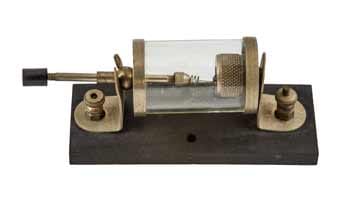
The first solid state detector specifically for use in radio receiving apparatus was patented by Sidney G Brown. He filed a patent on 3rd June 1904, just before the Bose patent was filed. Whilst the patent described a solid state electrolytic detector, this also encompassed the techniques used for solid state crystal detectors.
Brown used a pellet of lead peroxide powder compressed between lead and platinum. These detectors were used for many years, and were still being used up until the the late 1910s.
Another scientist who made some significant advances was Louis Austin of the US National Bureau of Standards. He devised a scheme that used a small cylinder of silicon or aluminium held by a block of tellurium. Although patents were applied for, the impetus behind the research dwindled and nothing really came of it.
All of these detectors did not produce practical detectors that were widely used. many did not secure any commercial success and others remained as laboratory demonstrations. The next stage in the crystal radio detector and the crystal radio itself was the development of commercially successful solutions.
First practical crystal detectors
There were two main people who are generally credited with developing a commercially viable crystal detector. One was named Greenleaf Pickard, and the other was Henry H C Dunwoody.
Pickard was working with an item called a microphone detector which was not covered by the patents of other inventors. It essentially consisted of an arrangement whereby carbon was held against steel and also there were series batteries and headphones.
The operation of the microphone detector was far from ideal as there was a constant background noise. To reduce the noise he progressively removed the batteries from the circuit, but found the noise was eliminated, but the signal could still be heard, although with a reduced strength.
This lead to further research where he tested a variety of different materials, eventually using some silicon and a point contact wire.
Around the same time, H H C Dunwoody, who was a Vice President of the de Forest Wireless telegraph Company filed a patent for a crystal detector. Dunwoody had undertaken many investigation into the rectifying properties of many materials including carborundum which is silicon carbide, SiC. Typically the crystals were quite long which enabled him to make contact to them using a few turns of wire around each end. The difference in the properties at each end made sure that the crystal rectified.
Dunwoody patented the idea on 2nd March 1906. The patent was worded to accommodate many variations and when Pickard's patent application was filed later, the one by Dunwoody had precedence.
First crystal radio sets
A variety of companies started to use crystal detectors in their radios. Some companies manufactured these detectors on their own.
Interestingly Packard and his attorney set up a company to manufacture crystal detectors and later they manufactured high quality radios. These are widely sought after in the vintage radio markets today.
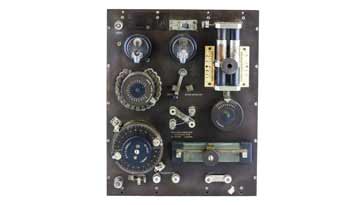
This vintage radio dated from around 1917 - 1918 - it was used in a 1.5kW field set and possibly other areas. It was able to use its crystal detector or other external detectors including a magnetic detector
Established companies like the Marconi Company also used crystal detectors in their radios. These crystal detector radios gave a significant improvement in performance over the coherers and magnetic detectors which had been used some years before, without the expense and need for batteries required by the valves or vacuum tubes that could also act as rectifiers.
Rise of broadcasting and domestic radios
Although the first radio broadcast was made in 1906 by Reginald Fessenden in the USA, and then after this a number of stations started some broadcasting, it was not until after the First World War and particularly after about 1920 that broadcasting started to expand and be open for many more people to enjoy.
To be able to receive the broadcasts people needed radio receivers that were affordable. Valve / vacuum tube radios were out of the question because of their expense and therefore crystal radio receivers became the popular type of radio.
Some people built their own radios, often making the components or at least some of them, themselves. This considerably reduced the cost of getting a radio that was operational. Crystals were available to but, and many components could be made.
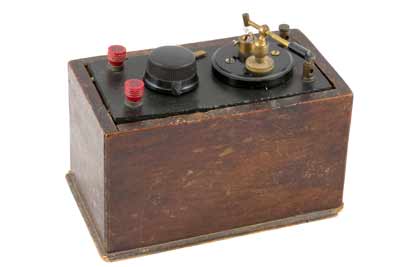
Some kit radios were also available. These were ideal for the people who may not have had all the expertise to make a radio from the raw materials. These sets were popular because the reduced the cost of obtaining a radio quite considerably.
A host of types of radio became available and they came in all shapes and sizes.
Many of the radios had only a box to contain the wiring beneath the main panel. This particular one below shows the magnificent capacitor used.
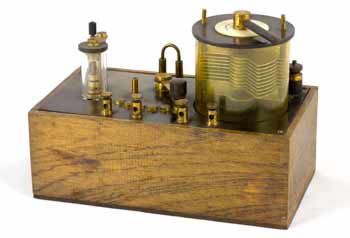
The set above was sold by the large department store in London, UK, called Gamages. This set was introduced in 1923. Most models had a lid, but this one did not appear to have ever had one.
Other crystal sets had coils that were mounted above the panel. This example shows the coil, cat's whisker detector and a switch, obviously for band-switching, along with the tuning capacitor control.
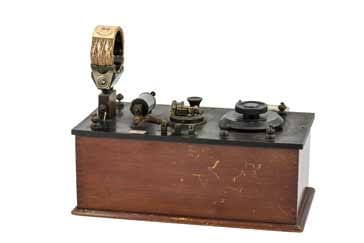
One popular approach to enclosing the crystal sets was to use a wooden box with a cover. This meant the crystal set / cat's whisker radio could be closed to prevent damage of any accidental change of the dials and settings.
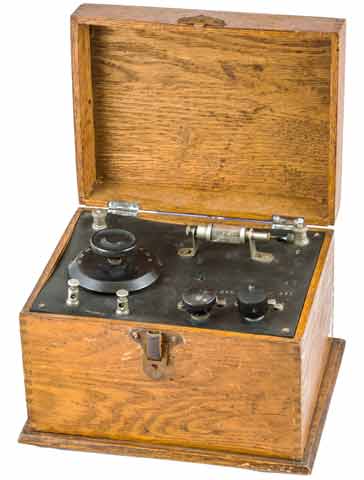
One of the more famous UK based brand names was that of the GECoPHONE - radios made by GEC. These radios were very popular and many thousands were amde and sold.
There were a number of different GECoPHONE radios - the one shown below was manufactured around 1923 and was the GECoPHONE No 1 radio. This had two versions, the BC1001 as shown below which had an uncovered detector, and the BC1002 which had a covered detector.
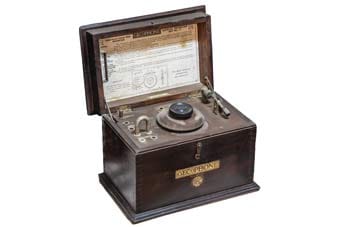
This actually shows the BC1001 version as there is no cover on the crystal detector
A vast number of companies made crystal radio sets for domestic use as the era of broadcast radio began. Many of these radios can be obtained as antique radios as vintage radio fairs, etc.
End of the crystal radio
As the 1920s drew to a close the number of broadcasting stations began to increase very rapidly. Initially this occurred int he USA, but other countries including the United Kingdom followed suit very shortly afterwards. With this, the need for greater levels of performance was felt - both improved selectivity and sensitivity were required. As the crystal set could not provide the performance required, this meant that new types of radio receiver were called for.
As indirectly heated valves or vacuum tubes became available, this considerably reduced the running costs of these radios as large batteries that were needed for the directly heated valve were not needed because they could be run from mains electricity. In addition to this, valves / vacuum tube production rose and accordingly the costs fell. This meant that valve powered radios now became affordable for many households
Initially many tuned radio frequency, TRF radios using regeneration to improve the selectivity and sensitivity were used, but also the superheterodyne radio started to be used. Some very clever designs where single valves wee used for multiple functions enabled only three or four valves to be used. These radios spelled the end of the era of the crystal set for mainstream use.
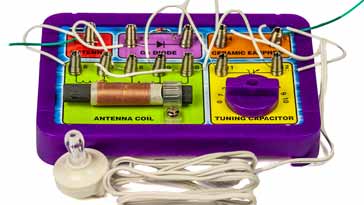
Despite these advances, many crystal set enthusiasts remained and the crystal radio was still used by a few. Some designs appeared in the radio magazines and some kits were available.
Even today, crystal radio set kits, especially ones that are easy to make are available. They can give a good demonstration of how a very basic radio works, laying the teaching foundations for further exploration of the technologies associated with radio.
Although the era of the crystal radio set was relatively short lived, during its time it enabled many companies and people to be able to receiver radio stations. During the 1920s, crystal radio sets formed the main technology for the reception of broadcast radio, laying the popularity of radio for many years to come.
Today, these radios from the 1920s or before are conisdered to be vintage radios or antique radios and they are soght afyer by vintage radio enthusiasts, and as such they can be sold for reasonable sums of money., although not quite the cost in real terms that they were when they were new.
 Written by Ian Poole .
Written by Ian Poole .
Experienced electronics engineer and author.
More History:
Radio history timeline
History of the radio
Ham radio history
Coherer
Crystal radio
Magnetic detector
Spark transmitter
Morse telegraph
Valve / tube history
PN junction diode invention
Transistor
Integrated circuit
Quartz crystals
Classic radios
Mobile telecoms history
Vintage mobile phones
Return to History menu . . .




